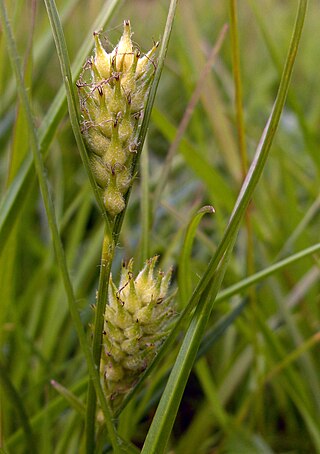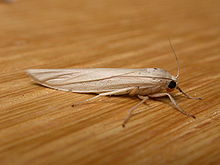
St Kilda is a remote archipelago situated 64 kilometres (40 mi) west-northwest of North Uist in the North Atlantic Ocean. It contains the westernmost islands of the Outer Hebrides of Scotland. The largest island is Hirta, whose sea cliffs are the highest in the United Kingdom; three other islands were also used for grazing and seabird hunting. The islands are administratively a part of the Comhairle nan Eilean Siar local authority area.

Hirta is the largest island in the St Kilda archipelago, on the western edge of Scotland. The names Hiort and Hirta have also been applied to the entire archipelago. Now without a permanent resident population, the island had nearly all of St Kilda's population of about 180 residents in the late 17th century and 112 in 1851. It was abandoned in 1930 when the last 36 remaining inhabitants were evacuated to Lochaline on the mainland.

Rudbeckia hirta, commonly called black-eyed Susan, is a North American flowering plant in the family Asteraceae, native to Eastern and Central North America and naturalized in the Western part of the continent as well as in China. It has now been found in all 10 Canadian Provinces and all 48 of the states in the contiguous United States.

Al-Hira was an ancient city in Mesopotamia located south of what is now Kufa in south-central Iraq.

The Edge of the World is a 1937 British film directed by Michael Powell, loosely based on the evacuation of the Scottish archipelago of St Kilda. It was Powell's first major project. The title is a reference to the expression ultima Thule, coined by Virgil.
Soay is an uninhabited islet in the St Kilda archipelago, Scotland. The name is from Old Norse Sauðey, meaning "island of sheep". The island is part of the St Kilda World Heritage Site and home to a primitive breed of sheep. Excluding Rockall, it is the westernmost point of the United Kingdom.

Miconia crenata, commonly called soapbush, clidemia or Koster's curse, is a perennial shrub. It is an invasive plant species in many tropical regions of the world, causing serious damage.

The lesser red musk shrew is a species of mammal in the family Soricidae. It is found in Angola, Botswana, Democratic Republic of the Congo, Malawi, Mozambique, Namibia, South Africa, Eswatini, Tanzania, Zambia, and Zimbabwe. Its natural habitat are savanna, subtropical or tropical dry lowland grassland, and hot deserts.

Calamidia is a genus of tiger moths in the family Erebidae.

The Boreray, also known as the Boreray Blackface or Hebridean Blackface, is a breed of sheep originating on the St Kilda archipelago off the west coast of Scotland and surviving as a feral animal on one of the islands, Boreray. The breed was once reared for meat and wool, but is now used mainly for conservation grazing. The Boreray is one of the Northern European short-tailed sheep group of breeds.

Hyparrhenia hirta is a species of grass known by the common names common thatching grass and Coolatai grass. It is native to much of Africa and Eurasia, and it is known on other continents as an introduced species. In eastern Australia it is a tenacious noxious weed. In South Africa, where it is native, it is very common and one of the most widely used thatching grasses. It is also used for grazing livestock and weaving mats and baskets.

The Patriarchal Province of Seleucia-Ctesiphon was an ecclesiastical province of the Church of the East, with see in Seleucia-Ctesiphon. It was attested between the fifth and thirteenth centuries. As its name entails, it was the province of the patriarch of the Church of the East. The province consisted of a number of dioceses in the region of Beth Aramaye, between Basra and Kirkuk, which were placed under the patriarch's direct supervision at the synod of Yahballaha I in 420.

Tricyrtis hirta, the toad lily or hairy toad lily, is a Japanese species of hardy herbaceous perennial plant in the lily family Liliaceae.

Euphorbia hirta is a pantropical weed, originating from the tropical regions of the Americas. It is a hairy herb that grows in open grasslands, roadsides and pathways. It is widely used in traditional herbal medicine across many cultures, particularly for asthma, skin ailments, and hypertension. It is also consumed in herbal tea form as folk medicine for fevers in the Philippines, particularly for dengue fever and malaria.

Carex hirta, the hairy sedge or hammer sedge, is a species of sedge native across Europe. It has characteristic hairy leaves and inflorescences, and is the type species of the genus Carex.

Ulochlaena hirta is a species of moth in the family Noctuidae first described by Jacob Hübner in 1813. It is found in south-eastern Europe and the Mediterranean region, east through Turkey, Iran and the Kopet Dag mountains to the southern Urals.

A cleit is a stone storage hut or bothy, uniquely found on the isles and stacs of St Kilda; whilst many are still to be found, they are slowly falling into disrepair. There are known to be 1,260 cleitean on Hirta and a further 170 on the other St Kilda-group islands.

Merremia hirta is a species of flowering plant in the family Convolvulaceae, native to India, southern China, Southeast Asia, Malesia, Papuasia, and Queensland. A twining herb, it is typically found in well-lit situations; grasslands, farm fields, roadsides, thickets, and forest edges, from sea level to 1,000 m (3,300 ft).
















